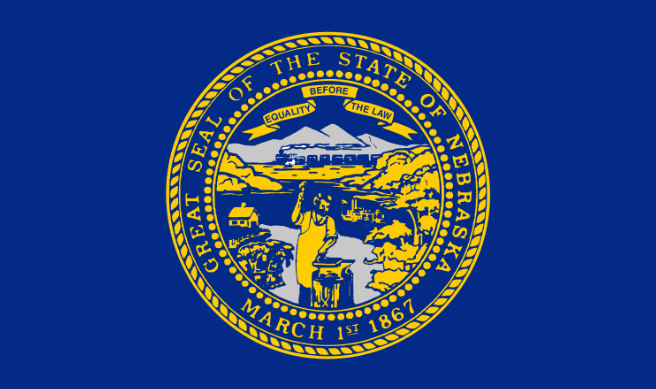United States
Nebraska : Equality Before The Law

Nebraska is a state located in the Midwestern region of the United States. Nebraska is bordered by Iowa to the east, Missouri to the south, South Dakota to the north, and Wyoming to the west. It is the only state in the United States with two panhandles. Nebraska’s area is 77,358 square miles (200,361 km2) with a population of 1,907,116 people as of 2019. Nebraska has been home to many Native American tribes before European exploration began in the 16th century. The Nebraska Territory was created in 1854 from parts of Kansas and Iowa territories. Nebraska became the 37th state of the United States on March 1, 1867.
Nebraska’s history is often defined by its relationship to racism and Jim Crow. Nebraska was a slave state before the American Civil War, but it did not secede from the Union. After the war, Nebraska became a destination for many African Americans looking to escape the racism and violence of the South. Nebraska was also home to some of the most racist and violent incidents in American history, including the brutal lynching of Will Brown in Omaha in 1919.
Despite its history, Nebraska is often seen as a progressive state. It was one of the first states to ratify the 13th Amendment, which abolished slavery. Nebraska was also one of the first states to grant women’s suffrage and to elect a woman to statewide office. Today, Nebraska is one of the most racially diverse states in the Midwest. Nebraska has come a long way since its early days, but its history of racism and violence cannot be ignored.
Racism is a systemic and pervasive problem that affects people across the United States, and Nebraska is no exception. While the state may not be as well-known for instances of racism as some other parts of the country, the effects of racism on Black people in Nebraska are significant and cannot be ignored.
One of the most visible effects of racism in Nebraska is the significant economic disparities between Black and white residents. According to data from the US Census Bureau, the poverty rate for Black Nebraskans is more than twice that of their white counterparts. This disparity is particularly concerning given that Black people in Nebraska are also more likely to experience joblessness and underemployment. This can lead to a cycle of poverty and hardship that can be difficult to break out of.
The effects of racism on Black people in Nebraska are not just limited to economic disparities, however. Racism can also impact the health and well-being of Black Nebraskans in a variety of ways. For example, Black people in Nebraska are more likely to experience stress, anxiety, and other mental health issues as a result of racism and discrimination. This can have serious long-term consequences for their physical health as well, as stress has been linked to a variety of negative health outcomes.
Another effect of racism on Black people in Nebraska is the increased likelihood of being involved in the criminal justice system. Black Nebraskans are significantly more likely to be stopped, searched, and arrested by police than white Nebraskans, despite being no more likely to engage in criminal activity. This can lead to a sense of fear and mistrust towards law enforcement, which can make it more difficult for Black Nebraskans to seek help or assistance when they need it.
Ultimately, the effects of racism on Black people in Nebraska are wide-ranging and complex. While some progress has been made towards addressing these issues, there is still a long way to go. It will require a concerted effort from individuals, organizations, and the government to dismantle systemic racism and ensure that Black Nebraskans are able to thrive and reach their full potential.
SUNDOWN TOWNS IN NEBRASKA
Sundown town, in U.S. history, a town that excluded nonwhite people—most frequently African Americans—from remaining in town after sunset.
Here is a current list of sundown towns in Nebraska. This list has been created by Tougaloo College in Tougaloo, MS. This list is a work in progress. Some cities have been confirmed as sundown towns and some are listed for other or similar reasons.
Adams County
Antelope County
Arthur County
Auburn
Aurora
Banner County
Blaine County
Boone County
Box Butte
Boyd County
Broken Bow
Brown County
Buffalo County
Burt County
Butler County
Cass County
Cedar County
Central City
Chase County
Cherry County
Cheyenne County
Clay County
Colfax County
Cozad
Crete
Cuming County
David City
Dawes County
Dawson County
Deuel County
Dixon County
Dodge County
Douglas County
Dundy County
Fairbury
Fillmore County
Franklin County
Fremont
Frontier County
Furnas County
Gage County
Garden County
Garfield County
Gering
Gosper County
Grant County
Greeley County
Hall County
Hamilton County
Harlan County
Harrison
Hayes County
Hitchcock County
Holdredge
Holt County
Hooker County
Howard County
Jackson
Johnson County
Kearney County
Keith County
Keya Paha County
Kimball County
Knox County
Lancaster County
Lexington
Lincoln
Lincoln County
Logan County
Loup County
Madison County
McPherson County
Merrick County
Minden
Morrill County
Nance County
Nebraska City
Nemaha County
North Platte
Nuckolls County
ONeill
Otoe County
Pawnee County
Perkins County
Phelps County
Pierce County
Plainview
Platte County
Plattsmouth
Polk County
Red Willow County
Richardson County
Rock County
Saline County
Sarpy County
Saunders County
Schuyler
Scotts Bluff
Seward County
Sheridan County
Sherman County
Sidney
Sioux County
Stanton County
Tecumseh
Thayer County
Thomas County
Valentine
Valley County
Wahoo
Wayne County
Webster County
West Point
Wheeler County
Wymore
Wynot
York County













You must be logged in to post a comment Login